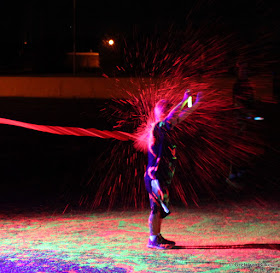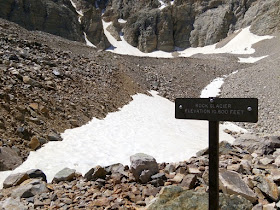The kids also really enjoyed the BLM's cave. It was cooled to a very pleasant 53 degrees Fahrenheit and had interpretive displays in the cave. Mostly, though, the kids thought it was super cool to hang out with their friends in the dark. Jim Goodbar, the BLM national cave and karst coordinator, brought the cave. He had taught a cave management class in Ely the week before.
With live music, tasty food, and several booths with information about caving, there was a nice array of things to do at Speleofest. The kids wanted to be active, so they had fun towing the SKED around on the grass. This is normally a tool for cave rescue, but the kids found some other ways to put it to use.
In the late afternoon it was time to head to the Art Bank for the opening reception of "The Caves of Absalom Lehman." This display featured photos taken by John and Mary Walker in 1928 and retaken in 2016 by Dave Bunnell. With the photos taken side by side, viewers could see what had changed over 88 years. In most cases, very little had changed, including regrowth of broken speleothems. The cave environment does not regenerate quickly at all. The Walkers' grandson attended and shared information about the height of his grandparents. Based on that, it's likely that his grandmother was the one taking the photos while his grandfather was illuminating the scene. The exhibit will be up through July 30 and then selected photos will be shown at Great Basin National Park.
Next up it was time for the Ely Neon Lights 5k. Over 160 participants walked, jogged, or ran along the course, which included several stations where you were sprayed with non-toxic neon paint that glowed under the black lights. Lots of participants put on special makeup or hair accessories to make the night glow even more. We were happy to do this with our friends Ron and Teresa.
It was a messy event!
We took showers at the high school afterwards.

We camped for the week at the Ely golf course. It was a really nice campground.
Folks set up tents along the greens.

Grottos (cave clubs) often camped together.
The campground also had a decon station so everyone could wash their clothes and gear after cave trips to keep from potentially spreading fungal spores that cause White Nose-Syndrome in bats.
The kids absolutely loved the Bat-Go-Round. It also makes an appearance at Black Rock each year for Burning Man.
The prize I picked was this super cute caving knit cap, also made by the Silver Sage grotto. Desert Girl was so happy to wear it.
Monday was a busy day. I gave two talks (but didn't manage to get a photo of our session), went to other talks, and caught up with cavers I hadn't seen for a long time. Here's my friend Andy giving a talk.
Desert Girl went to Vacation Bible School and then hung out with me and Teresa and Ron, while Desert Boy was in the Junior Speleological Society (JSS). He loved the variety of activities they had. Here he is practicing using a field phone next to the Cave Sim trailer.
Monday night was the Howdy Party, held under the hugest tents I think I've ever seen.

On Tuesday both Desert Boy and I climbed in the gym in the vertical contest. The kind volunteers helped me learn better techniques for climbing with knots. I took a photo of the record board, which was good, as my sit-stand record was beaten later in the day. And alas, I couldn't break the record despite my best efforts. I will have to keep trying! (And if I keep climbing long enough, I may get records in those older age group categories!) I did get first in my age group, which was nice, but my friend Amanda was only a few seconds behind, so I have pressure to keep practicing.

Desert Boy competed in his first climbing contest and did well, finishing second in his age group. The first place finisher broke the record in both 30 m and 120 m.
Next time we will have his system better fitted to him and he'll be climbing even faster.
Desert Girl didn't want to compete, but after she found out that two of her new friends had competed, she decided that next time she'll compete too.
The rest of the week sped by with giving more talks, organizing and leading cave trips, attending talks, attending meetings, checking out cave cartography, admiring cave art, signing books (An Un-Conventional Murder, set at the Convention sold well), buying new cave gear and books, and talking to lots of cavers. I didn't get many photos, it felt like I was always running from one place to another. We stayed up late every night, and the early sunrise had us getting up early. I started to feel like these guys:
It was all so much fun. We ended the week with the Awards Banquet. Lots of prep went into it.
The food was delicious, and it was a super evening with about 800 cavers under the big top. Total registration was 1080 cavers, more than most everyone had expected. People came from around the world to remote Nevada.
The next day we packed up and headed home and then met some scientists for a special cave tour of Lehman Caves to talk about history, microbiology, and more.
It was a super event. Thanks to Matt Bowers and all the Convention staff for putting on a successful convention!














































